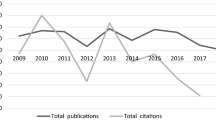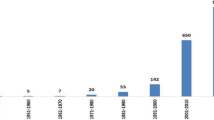Abstract
This study draws on publication and citation data related to plant biotechnology from a 10-year (2004–2013) period to assess the research performance, impact, and collaboration of member states of the Association of Southeast Asian Nations (ASEAN). Plant biotechnology is one of the main areas of cooperation between ASEAN member states and among the research areas promoted to achieve regional food security and sustainable development. In general, findings indicate increased scientific output, influence, and overall collaboration of ASEAN countries in plant biotechnology over time. Research performance and collaboration (domestic, regional, and international) of the region in plant biotechnology are linked to the status of the economic development of each member country. Thailand produced the most publications of the ASEAN member states while Singapore had the highest influence as indicated by its citation activity in plant biotechnology among the ASEAN countries. Domestic and international collaborations on plant biotechnology are numerous. Regional collaboration or partnership among ASEAN countries was, however, was found to be very limited, which is a concern for the region’s goal of economic integration and science and technology cooperation. More studies using bibliometric data analysis need to be conducted to understand plant biotechnology cooperation and knowledge flows between ASEAN countries.






Similar content being viewed by others
References
Abramo, G., D’Angelo, C., & Di Costa, F. (2009). Research collaboration and productivity: Is there correlation? Higher Education, 57(2), 155–171.
Adams, J. (2009). The use of bibliometrics to measure research quality in UK higher education institutions. Archivum Immunologiae et Therapiae Experimentalis, 57(1), 19–32.
Arunachalam, S., & Doss, M. J. (2000). Mapping international collaboration in science through coauthorship analysis. Current Science, 79(5), 621–628.
ASEAN. (2009, May). ASEAN cooperation in food, agriculture and forestry major achievements: ASEAN. Retrieved from ASEAN website http://www.asean.org/communities/asean-economic-community/item/asean-cooperation-in-food-agriculture-and-forestry-major-achievements.
ASEAN. (2015, January 12). ASEAN economic community. Retrieved from ASEAN website http://www.asean.org/communities/asean-economic-community.
Cheng, Y. (2006, October). Library connect: Elsevier. Retrieved March 6, 2015, from Elsevier website http://libraryconnectarchive.elsevier.com/lcn/0404/lcn0404.pdf.
Cohen, J. (2001). Harnessing biotechnology for the poor: Challenges ahead for capacity, safety, and public investment. Journal of Human Development, 2(2), 239–262.
Cohen, J., Komen, J., & Zepeda, J. (2004). National agricultural biotechnology research capacity in developing countries. Rome, Italy: Food and Agriculture Organization Agricultural and Development Economics Division.
Cole, J. (2000). A short history of the use of citations as a measure of the impact of scientific and scholarly work. In B. Cronin & H. Atkins (Eds.), The web of knowledge. A Festschrift in honor of Eugene Garfield. Medford, NJ: Information Today.
Colledge, L., & Verlinde, R. (2014, February). SciVal metrics guidebook: Elsevier. Retrieved March 6, 2015, from Elsevier http://www.elsevier.com/__data/assets/pdf_file/0006/184749/scival-metrics-guidebook-v1_01-february2014.pdf.
Ding, Y., Foo, S., & Chowdury, G. (1998). A bibliometric analysis of collaboration in the field of information retrieval. The International Information & Library Review, 30(4), 367–376.
Dalpe, R. (2002). Bibliometric analysis of biotechnology. Scientometrics, 55(2), 189–213.
Elsevier. (2014, December 26). Scopus. Retrieved from http://www.scopus.com/.
Elsevier. (2015). SciVal. Retrieved November–March 15, 2014–2015, from Elsevier research intelligence http://scival.com/home.
Erbisch, F., & Maredia, K. (1998). Intellectual property rights in agricultural biotechnology. Wallingford: CAB International.
Food and Agriculture Organization. (2013, November 19). Biotechnology: Food and agriculture organization. Retrieved from Food and Agriculture Organization website http://www.fao.org/biotech/fao-statement-on-biotechnology/en/.
Galison, P., & Hevly, B. (1992). Big science: The growth of large-scale research. Palo Alto, CA: Stanford University Press.
Garfield, E., Malin, M., & Small, H. (1983). Citation data as science indicators. In Y. Elkana, J. Lederberg, R. Merton, A. Thackray, & H. Zuckerman (Eds.), Toward a metric of science: The advent of science indicators (pp. 580–608). New York: Wiley.
Gastrow, M. (2008). Great expectations: The state of biotechnology research and development in South Africa. African Journal of Biotechnology, 7(4), 342–348.
Gibbons, M., Nowonthy, H., Limoges, C., Schwartzman, S., & Scott, P. (1994). The new production of knowledge. London, UK: Sage.
Glanzel, W. (2001). National characteristics in international scientific co-authorship relations. Scientometrics, 51(1), 69–115.
Glänzel, W. (2002). Coauthorship patterns and trends in the sciences (1980–1998): A bibliometric study with implications for database indexing and search strategies. Library Trends, 50(3), 461–473.
Glanzel, W., & Schubert, A. (2004). Analyzing scientific networks through co-authorship. In H. Moed (Ed.), Handbook of quantitative science and technology research (pp. 257–276). Netherlands: Kluwer.
Hagedoon, J., Links, A., & Vonortas, N. (2000). Research partnership. Research Policy, 29, 567–586.
Hassan, S.-U., Haddawy, P., Kuinkel, P., Degelsegger, A., & Blasy, C. (2012). A bibliometric study of research activity in ASEAN related to the EU in FP7 priority areas. Scientometrics, 91(3), 1035–1051.
Hautea, R., & Escaler, M. (2004). Plant biotechnology in Asia. AgbioForum, 7 (1and 2), 2–8.
James, C. (2012). Global status of biotech/GM crops. Ithaca, NY: International Services for the Acquisition of Agri-Biotech Applications.
James, C. (2013). Global status of commercialized biotech/GM crops: 2013. Ithaca, NY: ISAAA.
Karihaloo, J., & Perera, O. (2010). Agricultural biotechnologies in developing countries: Options and opportunities in crops, forestry, livestock, fisheries, and agro-industry to face the challenges of food insecurity and climate change. In Food and agriculture organization international conference on agricultural biotechnologies in developing countries (pp. 1–6). Guadalajara, Mexico: Asia Pacific Association of Agricultural Research Institutions.
Katz, J., & Hicks, D. (1997). How much is a collaboration worth? A calibrated bibliometric model. Scientometrics, 40(3), 541–554.
Komen, J. (1999). International collaboration in agricultural biotechnology. In J. I. Cohen (Ed.), Managing agricultural biotechnology addressing research program needs and policy implications (pp. 118–127). Oxfordshire: CAB International.
Kumar, S., Rohani, V. A., & Ratnavelu, K. (2014). International research collaborations of ASEAN nations in economics, 1979–2010. Scientometrics, 101, 847–867.
Lan, G. (2014). Research collaboration without borders. Bridgewater, NJ: Elsevier Research Intelligence, Analytical Services.
Lo, S. C. (2007). Patent analysis of genetic engineering research in Japan, Korea, and Taiwan. Scientometrics, 70, 183–200.
Melin, G., & Persson, O. (1996). Studying research collaboration using co-authorships. Scientometrics, 36(3), 363–377.
Moed, H., Glänzel, W., & Schmoch, U. (2004). Handbook of quantitative science and technology research: The use of publication and patent statistics in studies of S&T systems. New York, Boston, London, Moscow: Kluwer.
Moed, H., & Halevi, G. (2014). Tracking scientific development and collaborations: The case of 25 Asian countries. Research Trends.
National Agricultural Library. (2014, December 22). National agricultural library agricultural thesaurus library. Retrieved from National Agricultural Library http://agclass.nal.usda.gov/agt.html.
National Science Board. (2012). Science and engineering indicators 2012. Arlington, VA: National Science Foundation.
NIFA. (2014, December 6). Glossary of biotechnology terms: NIFA. Retrieved from USDA-NIFA website http://www.csrees.usda.gov/nea/biotech/res/biotechnology_res_glossary.html.
Pereira, T. (2000). A bibliometric study of the portuguese research system in biotechnology. Lisbon, Portugal: Instituto Nacional de Engenharia e Tecnologia Industrial.
Price, D. J. D. S. (1986). Little science, big science ... and beyond. New York: Columbia University Press.
Rigby, J. (2009). Comparing the scientific quality achieved by funding instruments for single grant holders and for collaborative networks within a research system: Some observations. Scientometrics, 78(1), 145–164.
Rosas, S., Kagan, J., Schouten, J., Slack, P., & Trochim, W. (2011). Evaluating research and impact: A bibliometric analysis of research by the NIH/NIAD HIV/AIDS clinical trials networks. PLoS ONE, 6(3), e17428.
Sevukan, R., Nagarajan, M., & Sharma, J. (2007). Research output of faculties of plant sciences in central universities of India: A bibliometric study. Annals of Library and Information Studies, 129–139.
Shari, S. (2012). Bibliometric and webometric methods for assessing research collaboration. Library Review, 61(8/9), 592–607.
Stvilia, B., Hinnant, C., Schindler, K., Worrall, A., Burnett, G., Burnett, K., & Marty, P. (2011). Team diversity and publication patterns in a scientific laboratory. Journal of American Society for Information Science and Technology, 62(2), 270–283.
Sutton, T.C. (2013). Publication parser tool for scopus. Version 2.0, Pullman, WA
The Royal Society. (2011). Knowledge, networks, and nations: Global scientific collaboration in the 21st century. London, UK: The Royal Society.
Times Higher Education. (2015, January 5). Times higher education Asia university rankings 2014. Retrieved from Asia university rankings 2014 top 100 website http://www.timeshighereducation.co.uk/world-university-rankings/2013-14/regional-ranking/region/asia.
UNESCO Institute for Statistics. (2015). Data center: UNESCO institute for statistics. Retrieved from UNESCO institute for statistics website http://www.uis.unesco.org/Pages/default.aspx.
Waltman, L., van Eck, N. J., van Leeuwen, T., Visser, M., & van Raan, A. F. (2011). Towards a new crown indicator: An empirical analysis. Scientometrics, 87(3), 467–481.
World Food Prize. (2013, December 12). 2013 Laureates: The World Food Prize. Retrieved from the World Food Prize http://www.worldfoodprize.org/index.cfm?nodeID=66969andaudienceID=1.
Acknowledgments
Thanks are due to Dr. Virginia Unkefer of King Abdullah University of Science and Technology Academic Writing Center for editing this manuscript and to George Lan of Elsevier for providing additional references that helped the authors design the methodology for this study.
Author information
Authors and Affiliations
Corresponding author
Rights and permissions
About this article
Cite this article
Payumo, J.G., Sutton, T.C. A bibliometric assessment of ASEAN collaboration in plant biotechnology. Scientometrics 103, 1043–1059 (2015). https://doi.org/10.1007/s11192-015-1582-x
Received:
Published:
Issue Date:
DOI: https://doi.org/10.1007/s11192-015-1582-x




